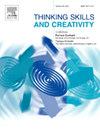Exploring the synergy of social-individual enablers of creativity in science: A multidimensional study of fourth graders
IF 4.5
2区 教育学
Q1 Social Sciences
引用次数: 0
Abstract
Creativity is a fundamental competency of the 21st century and its cultivation—particularly in science education—has attracted substantial interest. Indeed, enablers of creativity represent a dominant field in this regard. Based on “Confluence approaches”, the study chose 14,041 fourth graders from 309 primary schools from a city in the Central Region of China, all of which completed online questionnaires that looked into the individual enablers and social enablers of creativity in science. Results of the descriptive analysis of individual enablers showed that there was a decrease observed in students’ attitude toward science, interest in science, engagement in science learning, and career orientation toward science. While the LASSO and nomogram results indicated six common variables of social enablers including teachers’ concerns about students’ interests, individualized teaching, collaborative group teaching, the infrastructure of science, after-school service in science subjects, and parent engagement in daily life. These variables consistently emerged as pivotal when predicting the correlation between social and individual enablers of creativity in science. Teaching methods (individualized teaching, collaborative group teaching) were identified as the most influential social enablers on individual enablers of creativity in science. These findings provide valuable insight into what teachers, schools, and families should concentrate on to effectively support the expression and enhancement of student creativity in science.
探索科学创造力的社会-个人促进因素的协同作用:对四年级学生的多维研究
创造力是21世纪的一项基本能力,它的培养——尤其是在科学教育中——已经引起了人们极大的兴趣。事实上,创造力的推动者代表了这方面的主导领域。基于“合流方法”,该研究选择了来自中国中部地区某城市309所小学的14041名四年级学生,他们都完成了关于科学创造力的个人促成因素和社会促成因素的在线问卷调查。个体使能因素的描述性分析结果显示,学生对科学的态度、对科学的兴趣、对科学学习的参与和对科学的职业取向都有所下降。LASSO和nomogram结果显示了教师对学生兴趣的关注、个性化教学、合作小组教学、科学基础设施、科学学科课后服务和家长日常生活参与等6个共同的社会促进因素。在预测科学创造力的社会和个人推动者之间的相关性时,这些变量一直是关键。教学方法(个体化教学、合作小组教学)被认为是对科学创造力个体促进因素最具影响力的社会促进因素。这些发现为教师、学校和家庭应该集中精力有效地支持学生在科学方面的创造力的表达和增强提供了有价值的见解。
本文章由计算机程序翻译,如有差异,请以英文原文为准。
求助全文
约1分钟内获得全文
求助全文
来源期刊

Thinking Skills and Creativity
EDUCATION & EDUCATIONAL RESEARCH-
CiteScore
6.40
自引率
16.20%
发文量
172
审稿时长
76 days
期刊介绍:
Thinking Skills and Creativity is a new journal providing a peer-reviewed forum for communication and debate for the community of researchers interested in teaching for thinking and creativity. Papers may represent a variety of theoretical perspectives and methodological approaches and may relate to any age level in a diversity of settings: formal and informal, education and work-based.
 求助内容:
求助内容: 应助结果提醒方式:
应助结果提醒方式:


